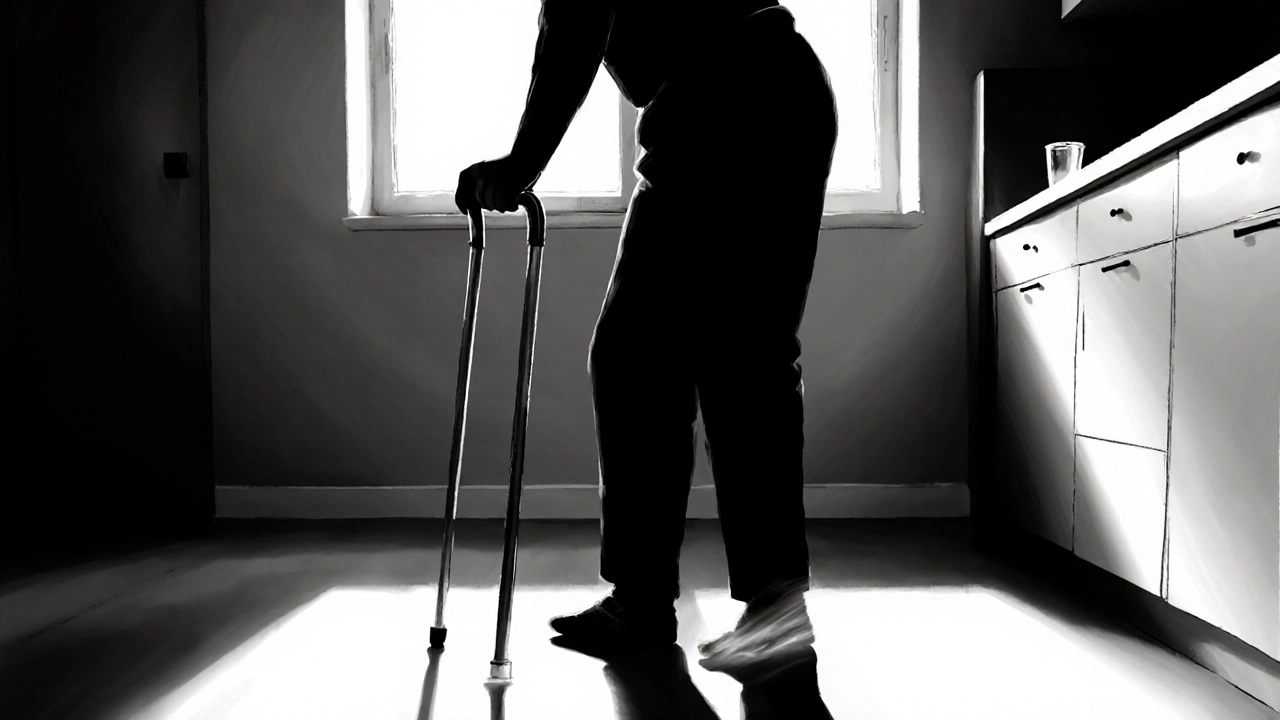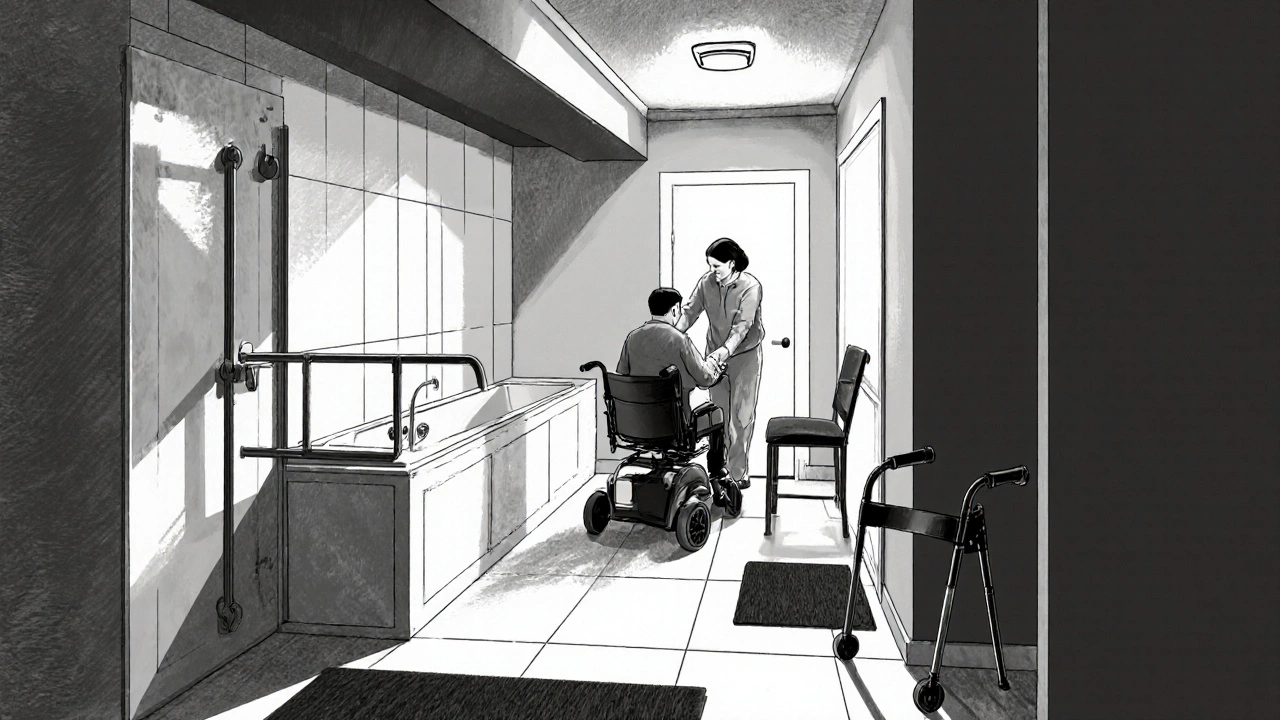Multiple Sclerosis Mobility Guide: Staying Independent

Living with Multiple sclerosis is a daily balancing act between symptoms and the desire to stay self‑sufficient. When mobility starts to feel shaky, the goal shifts from "can I move?" to "how can I keep moving on my own terms?" This guide walks you through practical steps-exercise, therapy, gear, and home tweaks-that let you keep control of your life.
Understanding Mobility Challenges in Multiple Sclerosis
Multiple sclerosis attacks the protective coating of nerve fibers, causing intermittent muscle weakness, spasticity, and balance loss. Those symptoms often show up as slow walking, frequent falls, or the need for a rest break after just a few minutes of activity. Recognizing the pattern-whether it’s a sudden flare‑up or a gradual decline-helps you choose the right intervention early.
Assessing Your Current Mobility
Before buying anything, conduct a simple self‑audit. Note how far you can walk without pain, how long you can stand before feeling dizzy, and which tasks-like reaching for a high shelf-feel unsafe. A professional gait analysis from a Physical therapist can turn those observations into measurable scores, giving you a clear baseline to track progress.
Exercise and Physical Therapy Strategies
Keeping muscles active fights the de‑conditioning that MS loves. A tailored Exercise program blends low‑impact cardio, strength work, and flexibility drills. For example, swimming 30 minutes twice a week boosts cardiovascular health without stressing joints, while resistance bands three times a week preserve leg strength.
Physical therapy isn’t just about exercises; it also teaches safe movement patterns. Therapists often use the principle of neuroplasticity-retraining the brain to use alternative pathways-to improve gait and balance. Consistency matters: short daily sessions beat occasional marathon workouts.
Choosing the Right Assistive Device
When walking becomes unreliable, Assistive devices become extensions of your body. The right choice balances support, portability, and confidence. Below is a quick comparison of the most common options.
| Device | Support Level | Portability | Best For |
|---|---|---|---|
| Cane | Low | Very high | Minor balance issues, indoor use |
| Walker | d>Medium | Moderate | Early-stage weakness, indoor & short outdoor trips |
| Power wheelchair | High | Low (needs charging) | Severe fatigue, long distances |
| Mobility scooter | Medium‑high | Moderate | Outdoor errands, shopping |
Try before you buy. Many clinics let you test a cane, walker, or scooter for a day. Pay attention to how natural the device feels and whether it reduces compensatory movements that could cause pain.

Home Modifications for Safe Independence
Even the best device can’t protect you from a slippery kitchen floor. Simple Home modifications make a huge difference. Install grab bars in the bathroom, replace bathtub steps with a walk‑in tub, and keep pathways clear of cords and rugs.
Lighting matters too. Motion‑sensor LEDs in hallways eliminate the need to fumble for switches at night. Threshold ramps, rather than steps, allow a wheelchair or scooter to glide easily between rooms.
Managing Fatigue and Energy Levels
Fatigue is the silent mobility killer for people with MS. Fatigue management starts with pacing: break tasks into 10‑minute chunks, rest, then resume. Use a daily energy log to spot patterns-maybe mornings are stronger, afternoons weaker.
Nutrition supports stamina. A diet rich in omega‑3 fatty acids, lean protein, and complex carbs steadies blood sugar and reduces inflammation. Hydration is often overlooked; dehydration can make heat‑sensitivity symptoms flare, making walking feel like climbing a hill.
Building a Support Network
No one expects you to master independence alone. Connect with a Occupational therapist who can suggest adaptive kitchen tools, dressing aids, and strategies for work. Peer support groups-online or in‑person-share tips on the latest assistive tech and give emotional encouragement.
Family members can assist by learning how to safely transfer you from a chair to a wheelchair, or by setting up weekly check‑in calls to monitor medication adherence and mood.

Putting It All Together: A Personal Mobility Plan
Take the pieces you’ve learned and sketch a weekly plan. Example:
- Monday, Wednesday, Friday: 30‑minute pool session (cardio + low impact).
- Tuesday, Thursday: Strength circuit with resistance bands (15 minutes) + balance drills (10 minutes).
- Daily: Energy log before breakfast; adjust activities based on trends.
- Weekly: Review device fit with therapist; adjust home modifications as needed.
- Monthly: Attend peer‑support meeting; share successes and challenges.
Revisit the plan every month. Small tweaks-like swapping a cane for a lightweight walker-can keep you moving forward without feeling stuck.
Key Takeaways
- Identify and track specific mobility challenges early.
- Incorporate regular, low‑impact exercise to preserve strength.
- Select assistive devices that match your support needs and lifestyle.
- Make strategic home changes to reduce fall risk.
- Manage fatigue through pacing, nutrition, and hydration.
- Lean on therapists and support groups for ongoing guidance.
Frequently Asked Questions
When should I consider a wheelchair instead of a cane?
If you notice frequent falls, significant leg weakness, or fatigue that makes walking more than a few minutes painful, a wheelchair (manual or powered) can preserve independence while reducing injury risk.
Can exercise worsen my MS symptoms?
When done at a moderate intensity and with proper warm‑up, exercise generally improves strength and reduces fatigue. Over‑exertion, however, can trigger a temporary symptom flare, so listen to your body.
What are the most affordable assistive devices?
A basic cane or a fold‑up walking stick can cost under $20. Portable walkers range from $50‑$150. For tighter budgets, explore local disability charities that offer loaner equipment.
How often should I reassess my mobility needs?
Aim for a formal reassessment every six months or sooner if you experience a new symptom, a fall, or a change in your daily routine.
Are there specific home modifications that pay off the most?
Installing grab bars in the bathroom, widening doorways for wheelchair access, and adding non‑slip flooring in high‑traffic areas provide the greatest safety boost for the lowest cost.
Katie Henry
October 16, 2025 AT 20:37We appreciate the thoroughness of this mobility guide; it lays out a clear roadmap for anyone grappling with MS. By emphasizing regular self‑audits and professional gait analyses, the article encourages proactive monitoring rather than reactive coping. The exercise recommendations balance cardio, strength, and flexibility, which aligns with current neuro‑rehab research. Moreover, the home‑modification checklist provides concrete, budget‑friendly steps that can be implemented immediately.
Joanna Mensch
October 18, 2025 AT 09:41Every device they sell is probably embedded with tracking chips to monitor our movements.
Nickolas Mark Ewald
October 19, 2025 AT 22:45It's great to see the focus on low‑impact activities like swimming; they really spare the joints while boosting stamina. Adding a few minutes of resistance‑band work each day can help keep leg muscles from weakening. Also, keeping a simple energy log can shine a light on the times of day when fatigue hits hardest.
Chris Beck
October 21, 2025 AT 11:49This guide is a waste of time it pretends to care but only pushes cheap British gear!!
Emily Rankin
October 23, 2025 AT 00:53Living with multiple sclerosis is a journey that tests both body and spirit, and the very act of seeking independence becomes a quiet act of rebellion. When the world seems to conspire against our balance, the simple decision to stand up again is itself a statement of defiance. The guide wisely reminds us that mobility is not just a physical capability but a profound expression of identity. Each recommendation, from gait analysis to home grab bars, is a brick in the foundation of self‑determination. By treating fatigue as a predictable rhythm rather than an unpredictable foe, we can choreograph our days with intention. Nutrition, hydration, and paced activity become the triad of empowerment, turning exhaustion into manageable pauses. The inclusion of assistive devices as extensions of the body reframes them from symbols of loss to tools of agency. Testing a walker before buying, as suggested, honors the personal nuance that no generic chart can capture. Moreover, community support-whether through peer groups or occupational therapists-offers a mirror in which we can see our own resilience reflected. The emphasis on regular reassessment acknowledges that our needs are fluid, and that flexibility of plan is essential. Even the smallest home tweak, such as a non‑slip rug in the kitchen, can prevent a cascade of setbacks. In this way, the guide weaves together medical advice and lived experience into a tapestry of hope. It invites us to view each setback not as a dead end but as a detour toward a new pathway of autonomy. The actionable weekly schedule serves as a compass, guiding us through the fog of uncertainty with tangible milestones. Ultimately, the message is clear: independence is not a static state but a dynamic practice, cultivated each day by intentional choices and compassionate support. Let us embrace this philosophy and step forward, one measured stride at a time.
Roberta Makaravage
October 24, 2025 AT 13:57🔍 The guide captures the essence of self‑determination, but remember that true autonomy also requires an understanding of neuroplasticity at the molecular level. 🎓 Studies show that consistent aerobic activity triggers BDNF release, which can facilitate remyelination-a fact many overlook. 📚 Therefore, supplementing swimming with interval training could amplify these benefits, something the article only hints at. 💡 Additionally, the recommended energy‑log should quantify caloric intake versus expenditure for optimal pacing. 🧠 Embracing such data‑driven strategies transforms the guide from a good checklist into a scientifically robust roadmap. 🚀
Lauren Sproule
October 26, 2025 AT 02:01i totally get u, roberta! the science stuff is super cool but i think the guide already does a great job staying simple enough for everyday use. also, remember to take breaks and not stress too much about tracking every single metric-sometimes just listening to your body is enough. keep it up, everyone!
CHIRAG AGARWAL
October 27, 2025 AT 15:05Honestly, I could skim this and still get the gist. Who has time to read all these tables?
genevieve gaudet
October 29, 2025 AT 04:09hey chirag, i feel you-reading long posts can be a chore, but the detailed tables actually save time later by helping you pick the right gear without trial‑and‑error. plus, sharing this info can help others who might be stuck looking for solutions.